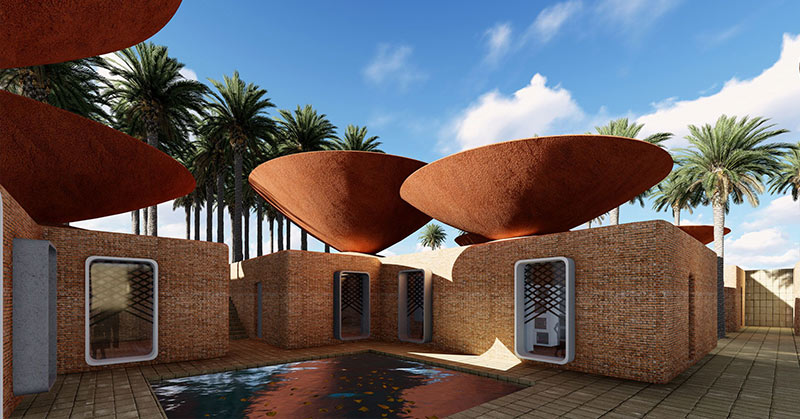BMDesign Studios is an Iran-based company that has structured homes with a natural insulation and cooling system. It’s called ‘Concave Roof’ and it’s a double-roof system with bowl-shaped slopes to collect rainwater in arid climates where a lack of water can lead to many issues for the population.
In places like Iran, precipitation is less than one-third of the average around the world, and evaporation is three times higher than the global average. This sort of climate has to balance a sustainable consumption of the limited water supplies among the population. Global warming threatens this balance, causing less rainfall and creating ‘salt marches’ where lakes and rivers used to be alongside growing populations and exhausted underground water supplies. This is the situation in Iran and it’s also happening in similar environments around the world. As time passes, the future may be marching toward a large displacement of people and uncontrolled immigration on account of the environment. [1] Rainwater collection can be problematic in areas with high evaporation rates and low precipitation.
Read: The Woman Who Lives 200,000 Years in the Past
The Design of Concave Roof
BMDesigin Studios responded to this climate issue with a strategy to improve the current water system and use global warming to the population’s advantage. According to the architects, this roof system could “help [make] even the smallest quantities of rain [flow down] the roof and eventually coalesce into bigger drops, just right for harvesting before they evaporate.” This includes morning dew in addition to regular rainwater. [2]
The outer section of the roof has another function besides collecting rain. It provides extra shade and allows air to flow between it and the inner roof, which naturally cools them. These buildings are structured around atriums to encourage a sense of community and wind circulation. [3]
Further research on this system is working on maximizing efficient rainwater collection. For now, a school building with 923 square meters of the concave rood can collect about 28 cubic meters of water, with an efficiency rate of approximately 60%.
The collecting systems are attached to reservoirs attached between building, which would aid the control of temperature fluctuation of the inside area with the water storing the heat, a design that will “[lower] the overall carbon footprint of much-needed air conditioning in this harsh environment,” according to the architects. [4]
When the studio set out to design this project, they had three main objectives:
- To see if they can use the changes of global warming to people’s benefit
- To produce water from unconventional sources that are infinitive for people in places with minimum rainfall.
- To form a solution that is aesthetically pleasing, distinct, and creates a sense of place. [1]
Read: A community of ‘voluntary anarchists’ is taking off-the-grid living to the next level
Collecting Rainwater in the United States
Would these work in the United Sates? Well, collecting rain is useful for watering plants, cleaning, bathing, etc. However, it is illegal in some states, so check your state’s laws and regulations before beginning. Some states, however, encourage citizens to collect rainwater. Rhode Island, Virginia, and Texas offer a tax credit or an exemption for all equipment bought for rainwater harvesting. [5]
As useful rainwater and convenient rainwater may be, it’s not pure and is often not safe to drink. Rain can contain contaminants from the outdoor containers, such as dirt, smoke, soot, dust, and bird droppings from the roof or walls, as well as bacteria, parasites, viruses, and chemicals that can make people sick. The risk of illness from drinking rainwater varies depending on the location, how often it rains, the season, and how the water is collected and stored.
For example, rain barrels don’t offer any kind of disinfection or filtration. Chlorine or iodine won’t protect the water from chemicals. Boiling water can eliminate germs but it won’t destroy any chemicals. Collected water intended for drinking needs to be properly filtered, disinfected, and tested regularly.
To avoid the complications of drinking impure water, consider using rainwater for watering flowers and other non-edible plants, washing objects that aren’t used for eating or cooking, and bathing (ensuring the water doesn’t enter your nose or mouth). On the flip side, avoid using rainwater for activities that may cause you to ingest the water, such as cooking, brushing your teeth, or watering a vegetable garden. Use safe tap water or filtered tap water for these purposes. [6]
The Bottom Line
This design concept seems brilliant and nicely adapted to the environment they’re meant for. While rainwater harvesting may have its downsides, considering the environments these are meant for the risks associated with this type of water collection seems acceptable as long as proper precautions are taken. I bet these would work well for those looking to live off-grid, too.
Keep Reading: 10 Perfect Places In North America To Live Off The Grid
- BMDesign Studios. Concanve Roof System. https://bmdesignstudios.com/portfolio/concave-roof-system/ (Published in Archdaily, Dezeen, Oxford University Press, BBC Garden ILL. Habitat, Designbook, etc.)
- Jessica Stewart. Ingenious Bowl-Shaped Roof Collects Rainwater to Provide Natural Cooling. My Modern Met. https://mymodernmet.com/concave-roof-bmdesign-studios/ January 4, 2017
- Lucy Wang. Bowl-shaped roofs harvest rainwater and promote natural cooling in arid environments. Inhabitat. https://inhabitat.com/bowl-shaped-roofs-harvest-rainwater-and-promote-natural-cooling-in-arid-environments/ January 2, 2017
- Sabrina Santos. This Concave Roof System Collects Rainwater in Arid Climates. Arch Daily. https://www.archdaily.com/802377/this-concave-roof-system-collects-rainwater-in-arid-climates
- World Population Review. States Where It Is Illegal To Collect Rainwater 2020. https://worldpopulationreview.com/states/states-where-it-is-illegal-to-collect-rainwater/
- Centers for Disease Control and Prevention (CDC). Drinking Water: Rainwater Collection. https://www.cdc.gov/healthywater/drinking/private/rainwater-collection.html July 18, 2013

